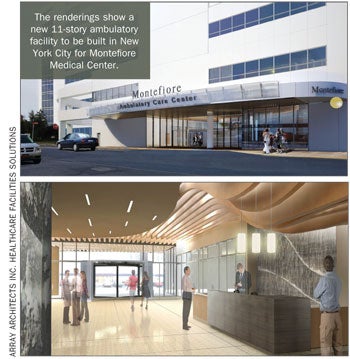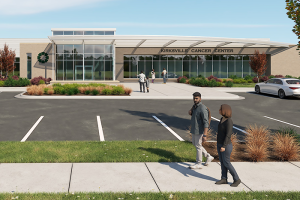'Bedless hospital' marks sign of the times
 With population-based health care delivery gathering momentum in the wake of health care reform, more hospitals are either constructing community-based facilities or are including them in their plans. The goal is to offer sophisticated levels of care at patient-friendly sites and reduce costs with fewer hospital admissions.
With population-based health care delivery gathering momentum in the wake of health care reform, more hospitals are either constructing community-based facilities or are including them in their plans. The goal is to offer sophisticated levels of care at patient-friendly sites and reduce costs with fewer hospital admissions.
Montefiore Medical Center is a perfect example of what is expected to become a growing trend. It recently announced plans to lease a new 11-story, 280,000-square-foot building at Hutchinson Metro Center, a mixed-use development in New York City.
The new construction project, scheduled for completion in the third quarter of 2014, will provide space for multidisciplinary care and integrate technology that allows Montefiore to provide necessary treatments without the need for hospitalization.
"This new tower will allow Montefiore to bring the health care of tomorrow to our patients here in the Bronx," says Steven M. Safyer, M.D., president and CEO, Montefiore Medical Center. "We are reshaping outpatient care and establishing leading practices that provide Montefiore's world-class treatments through multidisciplinary teams at a hospital without beds."
The decision to develop a freestanding ambulatory facility was due to many factors, including the ability to provide high-tech imaging and surgical procedures in an outpatient setting, says Ed Pfleging, vice president of engineering and facilities at Montefiore Medical Center.
The facility will include 12 operating rooms and four procedure rooms, which will allow more difficult cases requiring a hospital-type setting to be more easily scheduled and quickly completed, he says.
While not all new off-campus facilities will be as large as this one, the 2013 Hospital Construction Survey conducted by Health Facilities Management magazine and the American Society for Healthcare Engineering also identifies a trend involving increased community-based health care.
Of the 612 survey respondents, who include vice presidents and directors of facilities management and operations at U.S. hospitals, future facility development plans and construction projects include:
- ambulatory surgery centers, 11 percent of respondents;
- new medical office building construction, 15 percent;
- outpatient facilities in neighborhood settings, 15 percent;
- satellite offices catering to specialities, 11 percent;
- urgent care facilities in neighborhood settings, 12 percent.
Health Facilities Management will publish a special report on the survey in the February 2013 issue of the magazine.
According to the National Association of Community Health Centers, the number of Americans who rely on community health centers for care is expected to double to an estimated 40 million by 2015 — from about 20 million who relied on the centers in 2010. The Affordable Care Act allocated $11 billion to expand these centers, including $1.5 billion for construction.
Richard Taylor, managing director, health care solutions group, Jones Lang Lasalle, a real estate services firm based in Chicago, says health care systems are evolving into integrated delivery systems that reach out to their customers through a variety of facility types.
"It's all part of that overall trend that you can track back to the health care legislation and consumer preferences," he says. Lower cost of delivery and competition are two other key factors in the trend, he adds.
Marisa Manley, president, Healthcare Real Estate Advisors, agrees that the drive is in full swing for hospitals to move urgent, ambulatory and primary care to community-based sites to meet patient preferences and to cut costs.
Another positive outcome of the trend is that hospitals likely will start to utilize some of the empty buildings and office spaces caused by the Great Recession in addition to building new facilities when necessary, she says.




